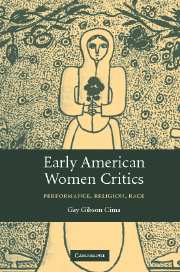Book contents
- Frontmatter
- Contents
- Acknowledgments
- Introduction
- 1 Colonial Women Critics: Performing Religion, Race, Possession, and Pornography
- 2 Revolutionary Women Critics: Performing Rational Christianity, Patriotism, and Race
- 3 Republican Women Critics: Performing Christian Activism, American Culture, and Race
- Index
- References
3 - Republican Women Critics: Performing Christian Activism, American Culture, and Race
Published online by Cambridge University Press: 22 September 2009
- Frontmatter
- Contents
- Acknowledgments
- Introduction
- 1 Colonial Women Critics: Performing Religion, Race, Possession, and Pornography
- 2 Revolutionary Women Critics: Performing Rational Christianity, Patriotism, and Race
- 3 Republican Women Critics: Performing Christian Activism, American Culture, and Race
- Index
- References
Summary
I had unusual life and liberty in speaking.
Jarena Lee, Religious Experience, 23Woman was never formed to be the abject slave of man. Nature made us equal with them, and gave us the power to render ourselves superior.
Susanna Rowson, Slaves in Algiers, 9From the 1780s through the 1820s, women critics expanded their access to public debates. Through newly devised host bodies, they demanded positions within the church, established literary societies, published essays and novels in the magazine and book market, took their complaints to court, wrote textbooks for the schools they founded, and staged their plays in newly built theatres. Performance continued to be crucial: they practiced public speaking within female academies, literary salons, and church circles and as they launched careers as actress-playwrights in newly politicized theatres. They strengthened ties with other women through benevolent associations, moral societies, and camp meetings. They preached. They imagined a specifically American womanliness, dedicated to life, liberty, and the pursuit of superiority. They articulated this superiority primarily as a standard of religious and moral dominance within Christian activism or as a standard of artistic sophistication and civilization within a specifically American culture. They assumed disparate host bodies as performing critics and as performance critics, shaping race, American-ness, and gender in the new republic, often through religion or American letters.
- Type
- Chapter
- Information
- Early American Women CriticsPerformance, Religion, Race, pp. 149 - 234Publisher: Cambridge University PressPrint publication year: 2006



